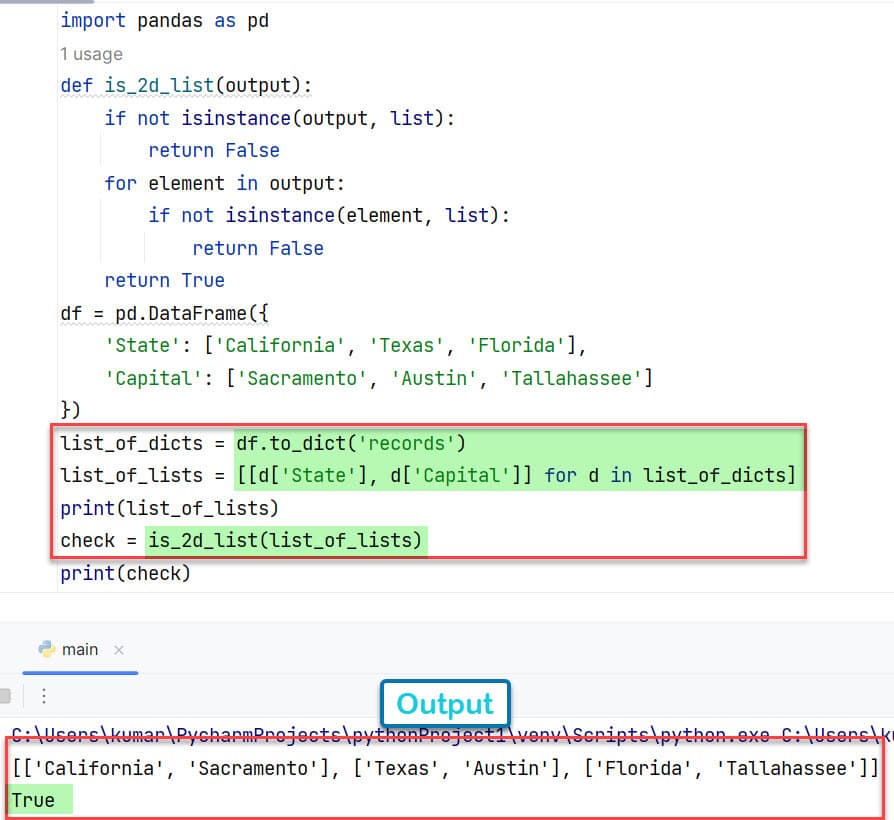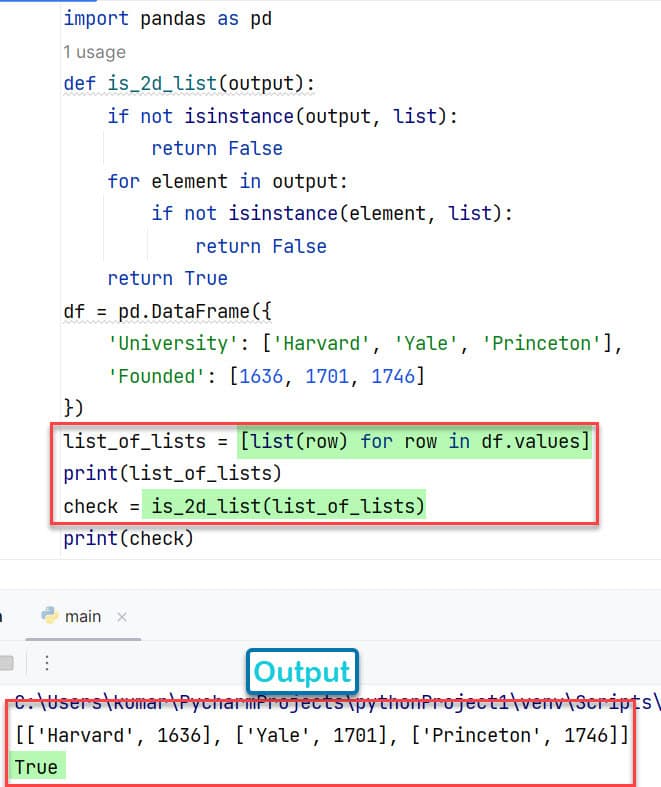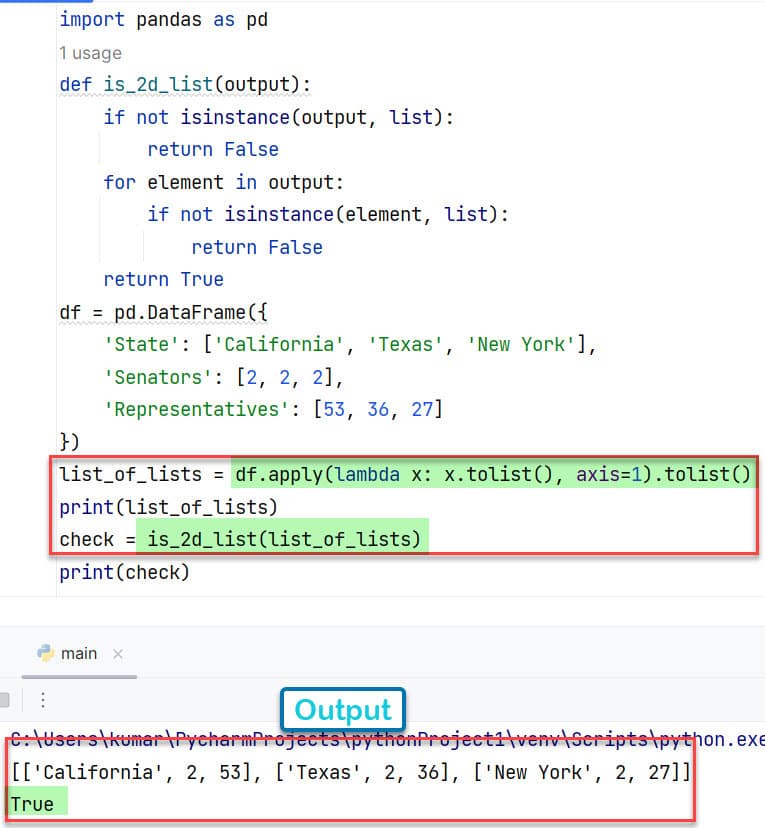Do you want to convert a dataframe to a list? In this Python tutorial, I will explain how to convert a Pandas dataframe to a list in Python using different methods with some illustrative examples.
To convert a Pandas DataFrame to a list in Python, various methods can be employed: the df.values.tolist() method for a direct conversion to a list of lists, the to_dict() function for creating a list of dictionaries, List Comprehension for customized list structures, and the apply() function to apply specific transformations to each row, ensuring flexibility and efficiency in the conversion process.
Convert a Pandas DataFrame to a list in Python
There are four different methods to convert a Pandas dataframe to a list in Python:
- df.values.tolist() method
- to_dict() function
- List Comprehension method
- apply() function
Let’s see them one by one using some demonstrative examples:
Note: To confirm that whatever we get as an output is a 2D list I have added a function to all of the methods: If the function returns True that means we get a 2D list in Python,
def is_2d_list(output):
if not isinstance(output, list):
return False
for element in output:
if not isinstance(element, list):
return False
return True1. DataFrame to 2D list using the df.values.tolist() method
The simplest way to convert a Pandas DataFrame to a list in Python is by using the values attribute followed by the tolist() method. This method converts the DataFrame into a list of lists where each inner list represents a row in the DataFrame.
import pandas as pd
def is_2d_list(output):
if not isinstance(output, list):
return False
for element in output:
if not isinstance(element, list):
return False
return True
df = pd.DataFrame({
'City': ['New York', 'Los Angeles', 'Chicago'],
'2018': [8398748, 3990456, 2705994],
'2019': [8336817, 3979576, 2695598]
})
list_of_lists = df.values.tolist()
print(list_of_lists)
check = is_2d_list(list_of_lists)
print(check)Output: The function defined will confirm that the output we get is a list of lists or 2D list in Python.
[['New York', 8398748, 8336817], ['Los Angeles', 3990456, 3979576], ['Chicago', 2705994, 2695598]]
TrueThe output of the code executed in Pycharm is illustrated in the screenshot below.

2. Pandas DataFrame to 2D list using the to_dict() function
If we prefer to have a list of dictionaries where each dictionary represents a row, with column names as keys, we can use the to_dict(‘records’) method to convert a Pandas DataFrame to a list in Python.
import pandas as pd
def is_2d_list(output):
if not isinstance(output, list):
return False
for element in output:
if not isinstance(element, list):
return False
return True
df = pd.DataFrame({
'State': ['California', 'Texas', 'Florida'],
'Capital': ['Sacramento', 'Austin', 'Tallahassee']
})
list_of_dicts = df.to_dict('records')
list_of_lists = [[d['State'], d['Capital']] for d in list_of_dicts]
print(list_of_lists)
check = is_2d_list(list_of_lists)
print(check)Output:
[['California', 'Sacramento'], ['Texas', 'Austin'], ['Florida', 'Tallahassee']]
TrueBelow is a screenshot showing the output after the code was executed in the PyCharm editor.

3. Pandas DataFrame to list of strings using list comprehension
List comprehension offers a flexible way to iterate over DataFrame rows and convert them into lists in Python. This method is highly customizable, allowing for more complex transformations during the conversion process.
import pandas as pd
def is_2d_list(output):
if not isinstance(output, list):
return False
for element in output:
if not isinstance(element, list):
return False
return True
df = pd.DataFrame({
'University': ['Harvard', 'Yale', 'Princeton'],
'Founded': [1636, 1701, 1746]
})
list_of_lists = [list(row) for row in df.values]
print(list_of_lists)
check = is_2d_list(list_of_lists)
print(check)Output:
[['Harvard', 1636], ['Yale', 1701], ['Princeton', 1746]]
TrueThe following screenshot illustrates the result after running the code in the PyCharm editor.

4. DataFrame to list using the apply() function
The apply() method applies a specified function along an axis of the DataFrame. It can be used to convert each row into a list in Python, offering a balance between simplicity and flexibility for more involved transformations.
import pandas as pd
def is_2d_list(output):
if not isinstance(output, list):
return False
for element in output:
if not isinstance(element, list):
return False
return True
df = pd.DataFrame({
'State': ['California', 'Texas', 'New York'],
'Senators': [2, 2, 2],
'Representatives': [53, 36, 27]
})
list_of_lists = df.apply(lambda x: x.tolist(), axis=1).tolist()
print(list_of_lists)
check = is_2d_list(list_of_lists)
print(check)Output:
[['California', 2, 53], ['Texas', 2, 36], ['New York', 2, 27]]
TrueThe output from the code executed in PyCharm can be seen in the screenshot provided below.

Conclusion
Here, I have explained four effective methods to convert a Pandas DataFrame into a list in Python. These methods include using the df.values.tolist() method for a quick conversion to a nested list, the to_dict() function for a list of dictionaries, utilizing List Comprehension for more customized transformations, and the apply() function for applying specific formatting to each row.
Each method offers a unique approach to handling DataFrame conversion, catering to different data processing needs.
You may also like to read:
- Convert a Pandas DataFrame to a Dict without Index in Python
- Convert a DataFrame to a Nested Dictionary in Python
- Drop Rows in Python Pandas DataFrames
- How to Convert Python Dictionary to Pandas DataFrame

I am Bijay Kumar, a Microsoft MVP in SharePoint. Apart from SharePoint, I started working on Python, Machine learning, and artificial intelligence for the last 5 years. During this time I got expertise in various Python libraries also like Tkinter, Pandas, NumPy, Turtle, Django, Matplotlib, Tensorflow, Scipy, Scikit-Learn, etc… for various clients in the United States, Canada, the United Kingdom, Australia, New Zealand, etc. Check out my profile.